#Chaucer'scharacters
Explore tagged Tumblr posts
Text
Unveiling the Timeless Masterpiece: The Canterbury Tales - A Window into Medieval Life
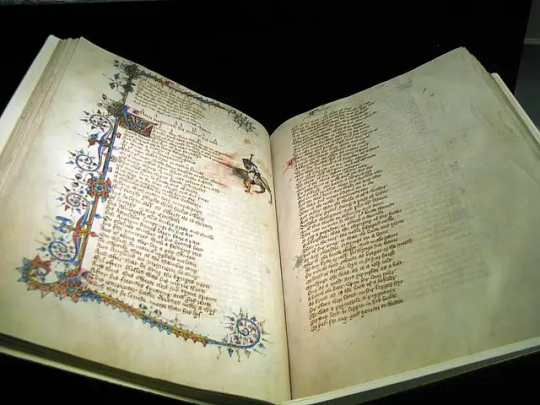
The Canterbury Tales by Geoffrey Chaucer is one of the greatest literary works of the Middle Ages and is considered a masterpiece of English literature. Written in the late 14th century, this enlightening work of fiction provides readers with a unique window into life during Medieval England. This collection of 24 stories is written in verse and is set in the context of a pilgrimage to Canterbury. The stories are told by a group of travelers, who are on their way to visit the shrine of Saint Thomas Becket in Canterbury. We will now explore the historical context of The Canterbury Tales, delve into some of the most famous tales, and the impact that the work has had on literature and culture. So, come join us on this journey as we explore the Canterbury Tales.
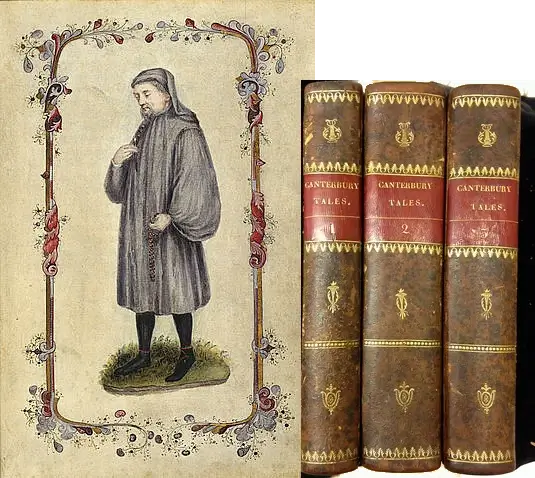
Canterbury tales volume set and Jeffery Chaucer. Photo by the British Library. THX News.
Context of Medieval England
Political Context Medieval England was characterized by a feudal system where the king held supreme power and granted land to nobles in return for their loyalty and military service. The peasantry, which comprised the majority of the population, worked on the lands of the nobles in exchange for protection and a share of the produce. The political instability of the period, due to frequent wars and disputes over the throne, led to growing dissatisfaction among the common people. The Canterbury Tales reflect this political context in several ways. The tale of the Knight, who is an embodiment of chivalry and loyalty, represents the idealized image of the nobles. The Pardoner, on the other hand, who cheats people for money, is a critique of the corrupt practices of the Church and State officials. Social Context The rigid social stratification of the Medieval period placed the aristocracy at the top and the peasantry at the bottom of the social ladder. Medieval society was patriarchal, and women had limited opportunities for education and employment. The Church played a significant role in the social structure and exerted its influence over all aspects of life, including education, law, and morality. Chaucer’s work reflects this social context in significant ways. The Miller and the Reeve, who are portrayed as buffoons, represent the lower classes, and their crude behavior contrasted with the refined and cultured qualities of the Monk and the Nun’s Priest. Religious Context Religion played a crucial role in the medieval society of England. The Church was viewed as the moral authority and was responsible for providing spiritual guidance to the people. Religious festivals, pilgrimages, and prayer were an integral part of everyday life. Christianity was the dominant religion, and other faiths were not tolerated. The Canterbury Tales reflects this religious context through the character of the Parson, who embodies the virtues of Christianity and represents the ideal spiritual guide. At the same time, the Friar and the Pardoner, who were both connected with the Church, are depicted as greedy and corrupt individuals who exploit the faith of the people for their own benefit.

A highlight of Decorated Gothic art the outer north porch c.1325 of St Mary Redcliffe, Bristol, England. Photo by Spencer Means. Flickr.
Overview of The Canterbury Tales
Historical Background The Canterbury Tales was written in a time that saw a significant transformation of English literature. In the late 14th century, English replaced Latin and French as the main language of literature. It was due in part to the efforts of writers like Chaucer, who sought to make literature accessible to all, regardless of their social status and education. Chaucer’s work marked the emergence of English as a literary language, which further contributed to the English language’s development. Themes and Style The Canterbury Tales is a complex work that incorporates various themes. The tales told by the characters bring out fundamental human endeavors, such as love, greed, and power. Chaucer’s views on social hierarchy and morality also permeate the tales. Humor and satire are other striking elements of the work, which add to its appeal. Each character’s tale is narrated in a distinct style that reinforces their characterization, making The Canterbury Tales a prime example of the art of characterization in literature. The Structure of The Canterbury Tales The structure of The Canterbury Tales is crucial to its style and thematic content. The work comprises 24 stories in total, broken down into tales told by twenty-three pilgrims, along with two tales told by the host. The pilgrims are representative of various sections of medieval society, from the high-ranking aristocrats to the working-class characters like the plowman and the miller. This range of characters and their tales effectively portrays medieval English society.
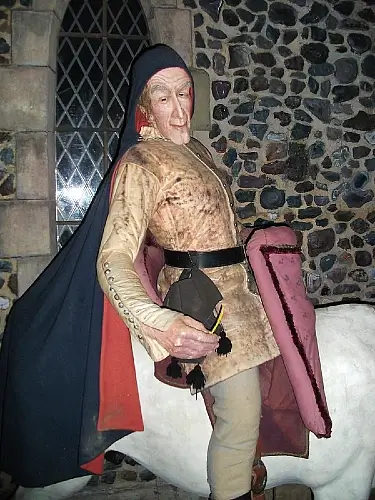
The Knight of The Knight's Tale. Photo by Ben Sutherland. Flickr.
Characters
The Knight The first character that comes to mind is the Knight, who is the epitome of chivalry and honor. He is described as "a worthy man" and has fought in many battles over the course of his life. His tunic bears the emblem of St. George, suggesting that he is a devout Christian. The Knight's tale is one of adventure and romance, and it explores the themes of love and loyalty. The significance of the Knight's character lies in his representation of the ideal of chivalry, which was highly valued during the Middle Ages. The Wife of Bath Another memorable character is the Wife of Bath, who is a self-proclaimed expert on marriage and love. She has been married five times and is not ashamed of it. In fact, she sees marriage as a means of achieving control over men. The Wife of Bath's tale is a feminist retelling of the story of King Arthur and his queen, and it explores the themes of power and gender roles. The significance of the Wife of Bath's character lies in her representation of unorthodox views on marriage and women's rights, which were radical in the Middle Ages. The Miller The Miller is another colorful character in The Canterbury Tales. He is a rude and vulgar man, who enjoys drinking and stealing. He is described as having a "red beard" and a "wide nostril" and is always ready to pick a fight. The Miller's tale is a bawdy one, which involves a love triangle and a lot of sexual innuendo. The significance of the Miller's character lies in his representation of the lower classes, who were often overlooked in Middle English literature. The Pardoner The Pardoner is a fascinating character, who is both repulsive and alluring. He is a religious figure who sells indulgences, which are supposed to reduce the time spent in purgatory. However, the Pardoner is a fraud, and he often makes up stories to convince people to buy his wares. He is described as having "hair as yellow as wax" and a "smooth, hairless face." The Pardoner's tale is a moral one, which explores the themes of greed and corruption. The significance of the Pardoner's character lies in his representation of the corruption within the Church. The Summoner The final memorable character we will discuss is the Summoner, who is a repulsive and grotesque figure. He is a religious official whose job is to summon sinners to appear before the Church courts. However, he is corrupt and often accepts bribes to let people off the hook. He is described as having a "fierce red face" and a "face full of pimples." The Summoner's tale is a scathing critique of the corruption within the Church, and it explores the themes of hypocrisy and greed. The significance of the Summoner's character lies in his representation of the corruption and moral decay within the Church.
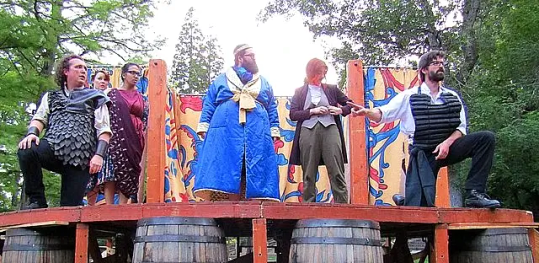
The Two Noble Kinsmen, Palamon and Arcite. Photo by Ben P L from Provo, USA. Wikimedia.
Themes
Social Hierarchy Social hierarchy was a prominent aspect of medieval society. As a result, Chaucer subtly incorporated it into his writing. In the story, The Knight's Tale, the character of Theseus is used to provide us with a glimpse into medieval royalty. He is portrayed as a respected and noble leader that people look up to. His social status gives him power, but also adds a weight of responsibility to his actions. The Boy's Tale is another story that presents us with the importance of social position. This tale focuses on the story of two friends, Arcite and Palamon. The two men are both in love with Emelye, but because Arcite is of nobler birth, his aspirations to marry her are more likely to be approved. The story shows how social status played a role in love and marriage during medieval times. Morality Morality plays a central role in many of the tales in the Canterbury Tales. Chaucer is seen as a master of his craft, capable of dealing with complex moral conundrums in a way that is relatable to readers. In The Pardoner's Tale, we see how greed can drive men to do terrible things. The tale exposes the corrupt nature of humans, who are always tempted by material things. The Wife of Bath's Tale teaches us about the importance of trust and compromise in relationships. She emphasizes how important it is to listen to each other's needs and desires. The tale also portrays a woman who has control over her own life. This was a revolutionary notion during the medieval era, when society was deeply patriarchal. Religion Religion is prevalent throughout the Canterbury Tales. People during the medieval era were devout believers and religion played a central role in everyday life. In The Man of Law's Tale, we see the story of a converted Jew who converts to Christianity. The story shows how religion can change a person's life and beliefs. The Friar's Tale, on the other hand, focuses on the immoral nature of some religious figures. The friar is portrayed as a corrupt individual who uses his position in the church for personal gain. This tale teaches us about the dangers of trusting those who claim to be religious simply because of their position.
Structure
The Canterbury Tales is a frame narrative, with the frame being the pilgrimage to Canterbury. The narrative framework of the tales is a crucial element as it sets the stage for the stories and binds them together. The pilgrims represent all sections of medieval society, from the nobility and the religious to the commoner, making it a unique representation of contemporary medieval life. The structure of the pilgrimage narrative is partly designed to encourage us as readers not merely to observantly read, but to actively participate in the journey. The stories in The Canterbury Tales have multiple levels of meaning, serving as both entertainment and social critique. The tales range from the high-minded Knight's Tale, which deals with questions of honor, courage, and justice, to the bawdy Miller's Tale, which serves as a very down-to-earth contrast. As the tales come to us, we are passive listeners who are participants in the journey, and the storytellers invite us to join the discussion. The tales also reveal a great deal about the people who are telling them, providing rich character studies. For instance, the character of the Wife of Bath is revealed in her story as she justifies her lustful tendencies. Classic Story Telling The story-telling structure is also a characteristic feature of the book's structure. The tale-tellers are introduced in the General Prologue, which provides a brief profile of each pilgrim. As the journey continues, each pilgrim tells one tale, resulting in 24 tales. However, it is the tale-telling structure that makes this book one of the most significant literary works of all time. The structure of the tales is both entertaining and educational, capturing the essence of medieval life. The tales in The Canterbury Tales exemplify the medieval genre of fabliaux, which means "little stories" in old French. Each story is a self-contained narrative, and the tales vary in length and complexity. Some reflect the traditions of romantic courtly love, while others satirize religious and secular institutions. The tales are all very different, and their distinctive storytelling style. The tales reveal the conditions of various medieval groups and offer insights into medieval ethics, morals, and religion. The variety of stories is a reflection of the wide diversity of society, which is a crucial feature of the overall narrative.
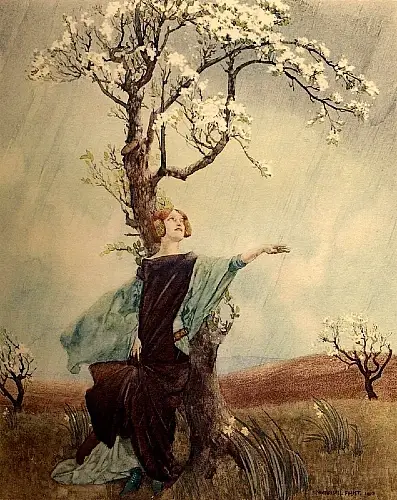
FLINT, William Russell 1880-1969. Chaucer's 'The Canterbury Tales', Frontispiece, 1928.. Photo by Halloween HJB. Flickr.
Significance to Literature and History
First and foremost, The Canterbury Tales is considered significant because it is considered a seminal work in the development of English literature. It was written in Middle English, which was the language spoken in England during the 14th century. The stories reflect the cultural and social norms of the time, allowing readers to get a glimpse into medieval life. This historic context provides a unique and insightful interpretation of one of the most significant pieces of English literature. Moreover, The Canterbury Tales is also considered significant for the way it challenges societal norms and the status quo. Chaucer’s works were known for being ‘bawdy’ and controversial. The Canterbury Tales, in particular, features characters who challenge societal norms, such as the Wife of Bath, who was seen as a feminist figure. The words and actions of the various characters in the stories also reflected a range of personalities and themes, providing a more nuanced interpretation of the medieval period. The English Religious and Socio-political Views of the Time The Canterbury Tales were also a reflection of the religious and socio-political situation of England. During the 14th century, English society was undergoing a period of transformation. England was transitioning from a feudal society to a more centralized government. The book includes a commentary on the corruption within the clergy and the institutionalized practices of the church. Chaucer uses his fictional stories to provide social commentary on the injustices of his time, and this provides a unique perspective on a tumultuous period in English history. The Canterbury Tales is a treasure trove of historical information that can be studied and dissected for years to come. The tales provide ample insight into the cultural, religious, social, and economic aspects of medieval life. The figures in the book reflect the interests, conflicts, and priorities of the medieval people, and understanding these figures provides insight into the complex lives of those who lived in these times.
Conclusion
The Canterbury Tales is a timeless classic that has endured for centuries and continues to influence literature, art, culture, and history. It serves as an important reminder of the values of Medieval England while also providing readers with insight into human nature. Through its tales of chivalry and romance, The Canterbury Tales offers us a glimpse into the lives of characters from all walks of life during this period in time. Those who read it come away with a better understanding of how society was structured during medieval times as well as what people valued most then. Whether you are looking for historical context or just want to get lost in some captivating stories, The Canterbury Tales will not disappoint! Sources: THX News & British Library. Read the full article
#CanterburyTales#Chaucer'scharacters#Englishliterature#Historicalcontext#MedievalEngland#Religioninmedievalsociety#Significancetoliteratureandhistory#Socialcritique#Socialhierarchy#Storytellingstructure
3 notes
·
View notes